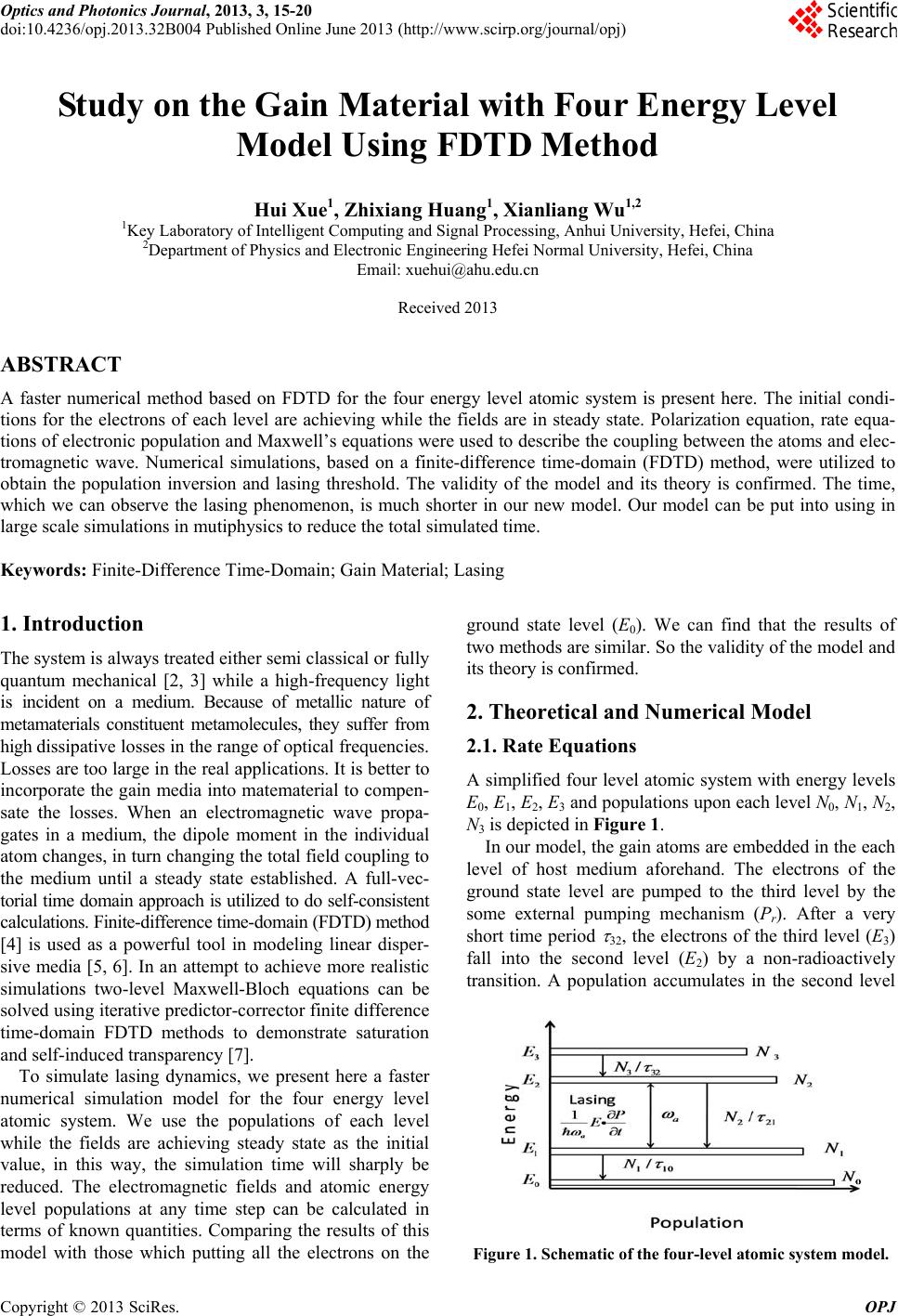
Optics and Photonics Journal, 2013, 3, 15-20
doi:10.4236/opj.2013.32B004 Published Online June 2013 (http://www.scirp.org/journal/opj)
Study on the Gain Material with Four Energy Level
Model Using FDTD Method
Hui Xue1, Zhixiang Huang1, Xianliang Wu1,2
1Key Laboratory of Intelligent Computing and Signal Processing, Anhui University, Hefei, China
2Department of Physics and Electronic Engineering Hefei Normal University, Hefei, China
Email: xuehui@ahu.edu.cn
Received 2013
ABSTRACT
A faster numerical method based on FDTD for the four energy level atomic system is present here. The initial condi-
tions for the electrons of each level are achieving while the fields are in steady state. Polarization equation, rate equa-
tions of electronic population and Maxwell’s equations were used to describe the coupling between the atoms and elec-
tromagnetic wave. Numerical simulations, based on a finite-difference time-domain (FDTD) method, were utilized to
obtain the population inversion and lasing threshold. The validity of the model and its theory is confirmed. The time,
which we can observe the lasing phenomenon, is much shorter in our new model. Our model can be put into using in
large scale simulations in mutiph ysics to reduce the total simulated time.
Keywords: Finite-Difference Time-Domain; Gain Material; Lasing
1. Introduction
The system is always treated either semi classical or fully
quantum mechanical [2, 3] while a high-frequency light
is incident on a medium. Because of metallic nature of
metamaterials constituent metamolecules, they suffer from
high dissipative losses in the range of optical frequencies.
Losses are too large in the real applications. It is better to
incorporate the ga in media into matematerial to compen-
sate the losses. When an electromagnetic wave propa-
gates in a medium, the dipole moment in the individual
atom changes, in turn changing the total field coupling to
the medium until a steady state established. A full-vec-
torial time domain approach is utilized to do self-consistent
calculations. Fin ite-difference time-domain (FDTD) method
[4] is used as a powerful tool in modeling linear disper-
sive media [5, 6]. In an attempt to achieve more realistic
simulations two-level Maxwell-Bloch equations can be
solved using iterative predictor-corrector finite difference
time-domain FDTD methods to demonstrate saturation
and self-induced transparency [7].
To simulate lasing dynamics, we present here a faster
numerical simulation model for the four energy level
atomic system. We use the populations of each level
while the fields are achieving steady state as the initial
value, in this way, the simulation time will sharply be
reduced. The electromagnetic fields and atomic energy
level populations at any time step can be calculated in
terms of known quantities. Comparing the results of this
model with those which putting all the electrons on the
ground state level (E0). We can find that the results of
two methods are similar. So the validity of the model and
its theory is confirmed.
2. Theoretical and Numerical Model
2.1. Rate Equations
A simplified four level atomic system with energy levels
E0, E1, E2, E3 and populations upon each level N0, N1, N2,
N3 is depicted in Figure 1.
In our model, the gain atoms are embedded in the each
level of host medium aforehand. The electrons of the
ground state level are pumped to the third level by the
some external pumping mechanism (Pr). After a very
short time period
32, the electrons of the third level (E3)
fall into the second level (E2) by a non-radioactively
transition. A population accumulates in the second level
Figure 1. Schematic of the four-level atomic system model.
C
opyright © 2013 SciRes. OPJ